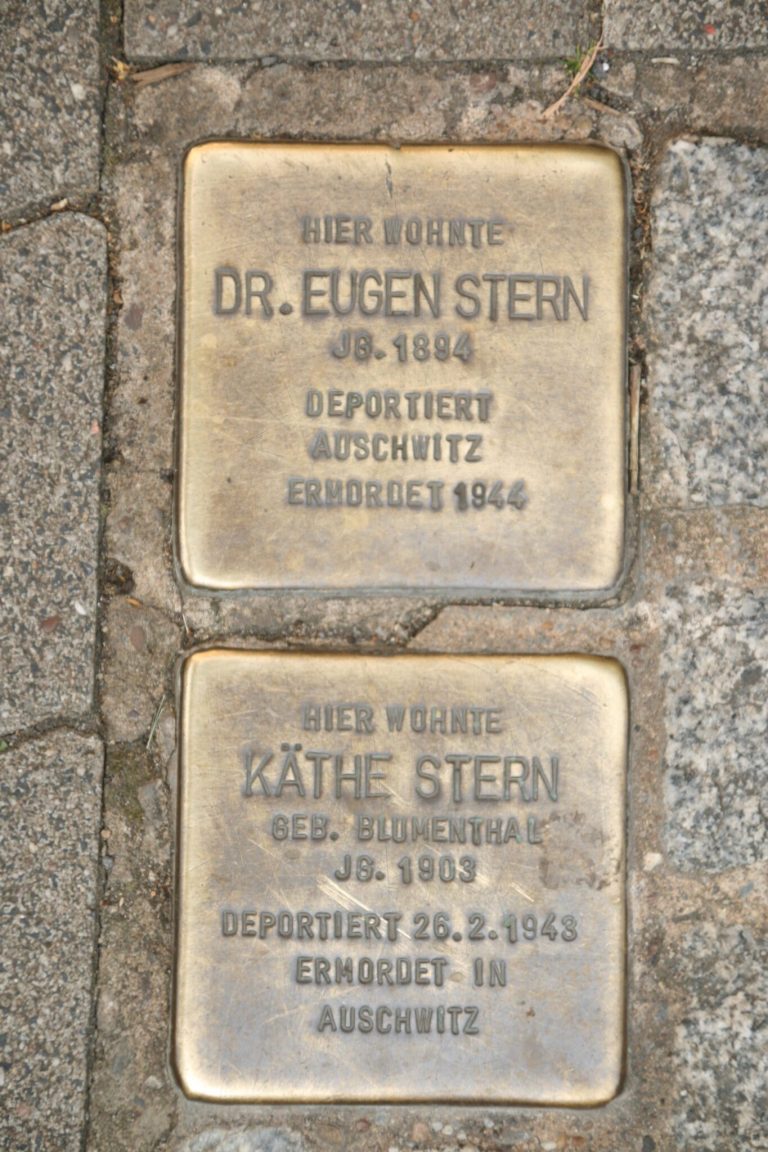
Germany has been coming to grips with its Nazi past, the deliberate slaughter of its Jewish citizens and destruction of Jewish culture. Before and during WWII, everything pertaining to Jewish life was targeted for violence and annihilation.
Under the Nazis, laws were successively passed that stripped Jews of citizenship, homes, businesses, degrees, valuables, jewelry, and winter clothing. The degradations were endless.
Places of worship were destroyed, sacred texts burned, property confiscated, destroyed, or turned over to non-Jews, culminating in the mass incarceration of Jews, inhuman transport to staging areas, slave labor work camps, concentration camps, and death camps. Even names were stripped, in the Nazi system victims were given a crude number tattoo.
Six million Jews were murdered, their ravaged bodies reduced to dust and ashes, and dumped in unmarked mass graves.
Birth records and official records were typically destroyed after they had been screened to identify Jewish ancestry, and especially as allied forces closed in to get rid of the evidence of crimes. The goal of the Nazi system was to brutally wipe Jews off the face of the earth.
In atonement, German jurisdictions have been erecting monuments and memorials to the victims. Some of which are more notable than others; each jurisdiction manages its own particular remembrances.
For the city of Koblenz (population 120,000) located at the juncture of the Moselle and Rhine Rivers, the Jewish population prior to the Nazis was 800-1000.
Of these 22 survived the Holocaust. Koblenz’s Jewish cemetery dates back 1,000 years. Jewish inhabitants now number about 1000, who mostly emigrated from former Soviet republics.
There were several lesser and major periods of persecution and tolerance toward Jews in German history. The medieval Jewish population of Koblenz was completely annihilated, Jews that had not succumbed to the plague were murdered by their neighbors.
Jews were historically barred from most professions, except for money lending, trade and finance, because managing money and bartering were not considered Christian endeavors, somehow believed to be tainted or sinful.
It wasn’t until the 1800s when France ruled the Rhineland that Jews were granted citizenship. Antisemitism increased after Germany lost WWI, culminating with WWII and the Holocaust.
Koblenz has numerous Holocaust memorials. The most interesting I was able to locate are by the German artist Gunter Demnig, who is best known for his Stolperstein (“stumbling block”) memorials to the victims of Nazi persecution, including Jews, homosexuals, Romani, mental patients, and the disabled.
They serve to highlight the inhuman scope of National Socialism and Nazi war crimes. The majority commemorate Jewish victims.
These are small, engraved brass plates embedded in front of a former residence of a victim who was deported and murdered. According to Wikipedia, Demnig’s memorials number more than 100,000 “stones” in 26 European countries, thus making the world’s largest memorial.
These are two Koblenz Stolperstein memorials:
HERE LIVED
EUGEN STERN
BORN 1894
DEPORTED TO AUSCHWITZ
MURDERED 1944
HERE LIVED
KÄTHE STERN
BORN BLUMENTHAL
1908
DEPORTED 26 FEBRUARY 1943
MURDERED IN
AUSCHWITZ
A historian I consulted informed me that many Koblenz Jewish victims were educated professionals, which also fostered jealousy among neighbors.
Neighbors and friends were often those who identified Jews, turned them in, participated in the roundups, and received their property and belongings. In the case of Dr. Stern, the same people that Dr. Stern would have helped, nursed back to health and deliver their children.
It never ceases to amaze me how cruel and evil people can be.
Koblenz has many Stolperstein. I also found about 30 other memorial bricks in a sidewalk next to Liebfrauenkirche (the Church of Our Lady, dating to 1200).
Most of these bricks are not as finely crafted, many had only a first name. Many records did not survive WWII, when local people were consulted decades later they may have only recalled a first name.
One thing to note with these memorials is there are no graves or tombstones, victims and their possessions were purposefully obliterated. Many have no living descendants, so homage to their ancestors ended with the Holocaust.
Another thing, I seemed to be the only one stopping and looking down at the memorials when encountered in a sidewalk or street. An elder person saw me doing so, briefly stared, then like everyone else simply walked on.
I continued my search not far from the river at the edge of night. There are no words for this night. There is only the flicker of light while humanity moves on from the middle of nowhere.
Each of us is a link in the long chain of humanity. If it breaks we all bleed.
On one side are violence, genocide, death, evil, and war. The other side, and I really hope we’re on the other side, is bright with the need for the light that nourishes life and the generations dance with us.
There is no way to make victims whole, but we take care of them by preserving their memory. I will always remember them on the way to eternity.
Stephen Cipot
Garden City Park







Dear Stephen, once again you have attempted to articulate what can’t be made luminous and sane.
May your heart hold what your mind clings to.
Warm regards, as always,
Charles